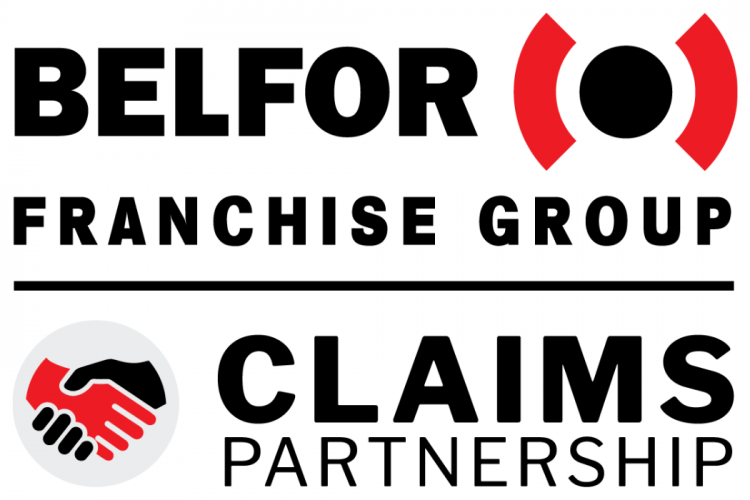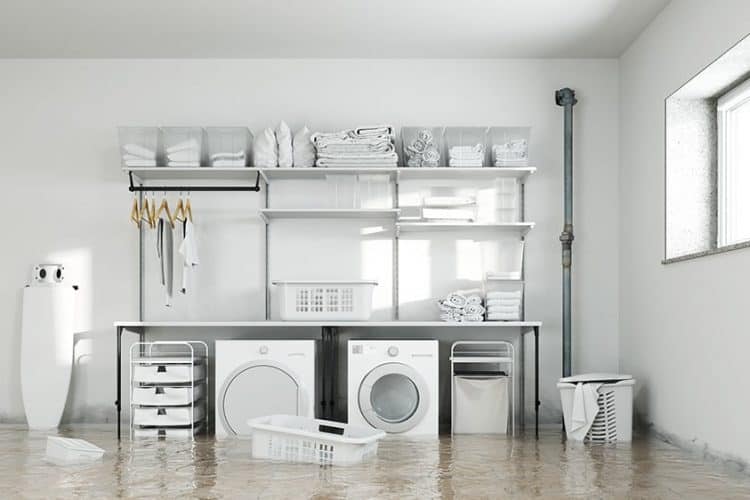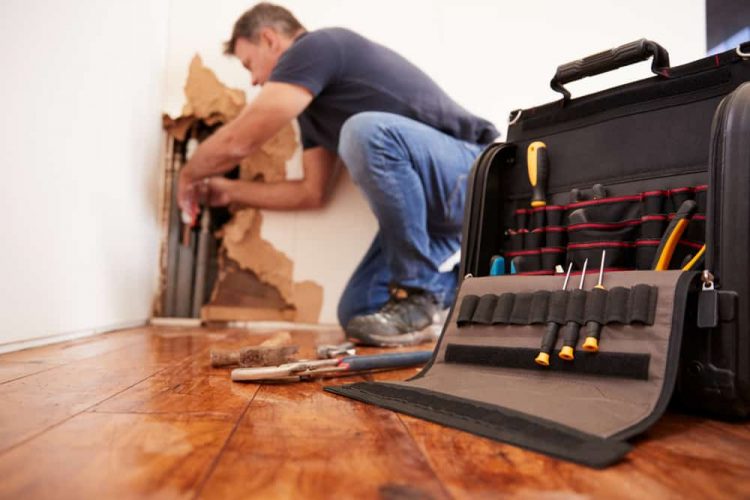On any given day, water damage emergencies affect about 14,000 homes. Water can enter your home from a water emergency like flooding or excessive rain, but it can also come from a leaky faucet or a bathtub that overflows. However your home sustains water damage, it’s important to treat it properly and handle it as quickly as possible. That’s where water mitigation comes into play. We’ll walk you through this guide to water mitigation to help you keep your house and property free from water damage.
What Is Water Mitigation?
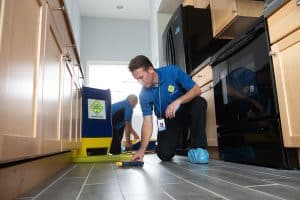
Water mitigation is the process of assessing, containing, and preventing further water damage immediately after an initial event occurs. The goal is to reduce property loss from a water leak or flood by stopping the water damage from spreading and causing secondary damage. Usually this process involves removing water, drying, sanitizing, and cleaning. Water mitigation should be the first step after a water leak or upon noticing any water damage. While some water mitigation steps can be done by the homeowner, most of the time a thorough water mitigation process should be done by an expert.
What Is the Water Mitigation Process?
When a water mitigation team comes to your property, they’ll follow these basic steps to stop the spread of damage and to save as much property as possible.
Stop the Flow of Water
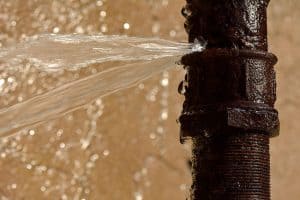 The first step in water mitigation is to stop the flow of water into your property. If water is still leaking into the space, all the other steps of the water mitigation process won’t do much to help reduce damage. For damage from a flood, it’s usually clear when the flow of water has stopped. But for a leak from a pipe or an appliance, the first step for the mitigation team is to ensure the water supply has been turned off and the cause of the leak has been, or will be, addressed by a plumber. Once water isn’t entering your property, the water mitigation team can really start their work.
The first step in water mitigation is to stop the flow of water into your property. If water is still leaking into the space, all the other steps of the water mitigation process won’t do much to help reduce damage. For damage from a flood, it’s usually clear when the flow of water has stopped. But for a leak from a pipe or an appliance, the first step for the mitigation team is to ensure the water supply has been turned off and the cause of the leak has been, or will be, addressed by a plumber. Once water isn’t entering your property, the water mitigation team can really start their work.
Assess the Situation
Before taking any action, the water mitigation experts will need to see what they’re facing. The restoration industry uses two systems for assessing water damage: Category and Class. Your team of experts will use both of these to figure out the extent of damage your property has.
Categories of Water Damage
The water damage category considers the source of the water damage and the level or range of contamination. The three categories of water damage are:
- Category 1: Water comes from clean or sanitary sources of water like a burst pipe (supply line only), broken toilet tank, or overflowing bathtub (unused water).
- Category 2: Water from a source that contains considerable contamination from organic or inorganic matter and microorganisms. Overflow from your dishwasher or washing machine machine or a broken aquarium would be categorized here. This may sometimes be known as gray water.
- Category 3: Water originates from a “grossly contaminated” source like sewage, flooding from any body of water, or surface water runoff. Category 3 water can contain pathogens, chemicals, and other harmful agents. You may sometimes see this referred to as “black water.”
Classes of Water Damage
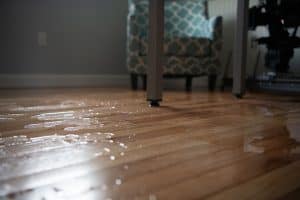
The water damage class tells you the extent of water damage based on the amount of water present and how much has been absorbed by the affected materials or building components. The four classes of water damage are:
- Class 1: Water damage, or intrusion, at the lowest level. The impacted materials make up less than 5% of the combined surface area of the walls, floor, and ceiling in the space.
- Class 2: A significant amount of water absorption has occurred. Wet, porous materials make up around 5%-40% of the combined surface area of the walls, floor, and ceiling in the impacted space.
- Class 3: Class 3 losses involve the greatest amount of water absorption, with impacted materials making up more than 40% of the combined surface area of the walls, floor, and ceiling in the affected space.
- Class 4: Think of this as deep water damage, meaning there’s “deeply held or bound water” in materials that do not absorb water very easily, such as plaster, hardwood, or concrete. These are considered “low evaporation materials,” which may require longer drying times and specialized drying methods.
Once a water mitigation team determines the category and class of the damage, they can determine what the next best steps are and if the property is safe for the residents to remain in.
Perform Water Extraction and Dry Out the Space
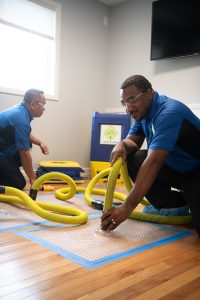 Based on the class and category, the water mitigation team will choose the right tools to remove any standing water that’s still in the damaged space. Once all excess water has been extracted from your property, they’ll move on to drying out the space the rest of the way. Proper, thorough drying is necessary to restore normal moisture levels and help prevent mold growth or other secondary damage from occurring. Some of the equipment they might use includes pumps, vacuums, dehumidifiers, air scrubbers, and heavy-duty fans.
Based on the class and category, the water mitigation team will choose the right tools to remove any standing water that’s still in the damaged space. Once all excess water has been extracted from your property, they’ll move on to drying out the space the rest of the way. Proper, thorough drying is necessary to restore normal moisture levels and help prevent mold growth or other secondary damage from occurring. Some of the equipment they might use includes pumps, vacuums, dehumidifiers, air scrubbers, and heavy-duty fans.
Provide Temporary Solutions
Once your property is drying out, the mitigation team may recommend temporary solutions to help prevent additional water from entering your property while it’s drying out, and until you can get the rest of your repairs done. Some of these solutions might include covering holes with tarps or boarding up broken windows. Depending on the specific capabilities and scope of work covered by each mitigation team, another contractor may need to be brought on to assist. If that’s the case, the restoration company handling mitigation should be able to refer you to one of their trusted partners.
Create a Restoration Plan of Action
Your professional mitigation team will work with you to develop the best plan of action to restore your property to its pre-loss condition. This will likely be covered during their initial walkthrough and assessment of the water damage to ensure everyone is on the same page about what exactly needs to be done before they begin any work. Your full restoration plan should cover things like:
- An estimated timeline
- An overview of what can be salvaged/repaired versus what should be thrown away/replaced
- Key steps in the process like water extraction, drying, sanitizing, etc.
- Recommendations for additional repairs, if needed
Water Mitigation vs. Water Damage Restoration
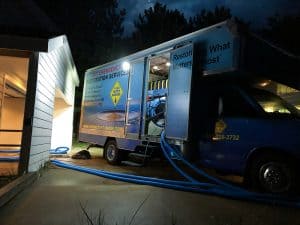 Many people wonder what the difference is between water mitigation and water damage restoration. Both of these processes are important steps in repairing water damage, and the terms are often used almost interchangeably, but there is one key difference. Water mitigation involves the immediate measures you take to minimize–or “mitigate”–the total damage incurred. These are the very first steps in the larger water damage restoration process that help limit the overall impact of the loss and reduce the risk of secondary damage (such as mold growth).
Many people wonder what the difference is between water mitigation and water damage restoration. Both of these processes are important steps in repairing water damage, and the terms are often used almost interchangeably, but there is one key difference. Water mitigation involves the immediate measures you take to minimize–or “mitigate”–the total damage incurred. These are the very first steps in the larger water damage restoration process that help limit the overall impact of the loss and reduce the risk of secondary damage (such as mold growth).
Water damage restoration comprises all the repairs that take place after mitigation– once the property is fully dried out. These are the parts of the process that bring your property back to its clean, safe, pre-loss condition. What all is involved in restoration depends on the nature of the loss, but steps may include sanitizing, antimicrobial application, cleaning or reinstalling carpet, repairing floors, or patching drywall.
Does Homeowners Insurance Cover Water Mitigation?
After a water damage event occurs and you call in a water mitigation team, you might be wondering if your homeowners insurance will cover the costs. The short answer is that it all depends on the source and timing of the leak.
Generally speaking, homeowners insurance will cover the costs of water damage mitigation if the leak comes from an accidental or sudden event inside your home, such as a burst pipe or appliance overflow. It won’t, however, cover gradual water damage that results from normal wear and tear or a lack of maintenance on a home. For example, if you have water damage from a leaky roof, and the roof is leaking because it’s old and needs to be repaired or replaced, your insurance won’t cover the expense. On the other hand, if a tree falls on your roof during a heavy rainstorm and causes rain to leak into your house, your homeowners insurance would likely cover the affiliated water damage mitigation.
It’s important to note that water damage caused by flooding is never covered under homeowners insurance policies. If you live in a flood-prone area, you should consider having a separate flood insurance policy.
The only way to be 100% sure whether or not your insurance would cover a water damage claim is to review your individual policy. The best way to be prepared is to familiarize yourself with your coverage before any event occurs, and contact your insurance agent if you have any questions.
Find the Right Water Mitigation Company
When there’s a leak in your home, it’s crucial that you respond immediately. To do that, you need a water mitigation team staffed with experts and ready to respond. Here at 1-800 WATER DAMAGE, our priority is to protect your property from water damage, and our water mitigation teams are prepared and prompt. We’ll help you remove water, dry out your property, and get your home back to the way you like it. Contact 1-800 WATER DAMAGE today and have our water mitigation experts help you and your property.

